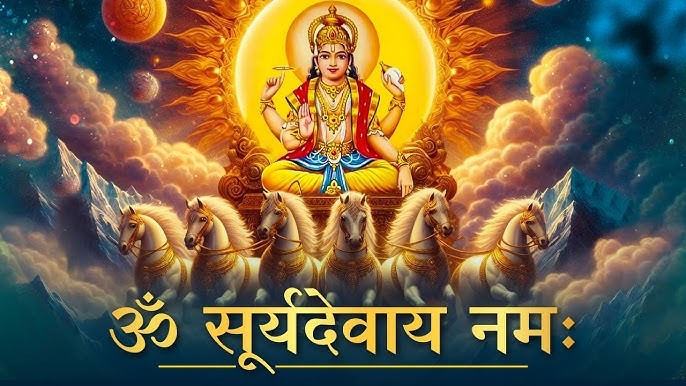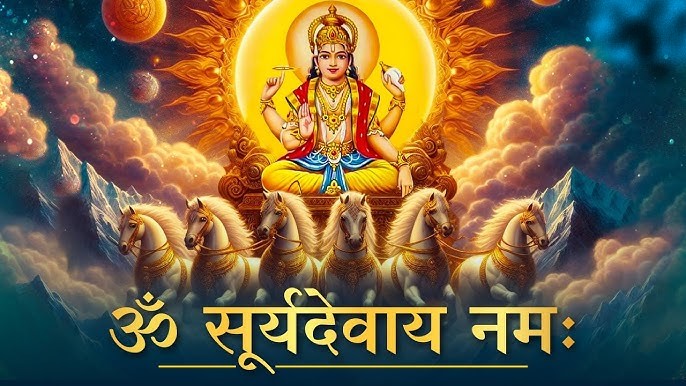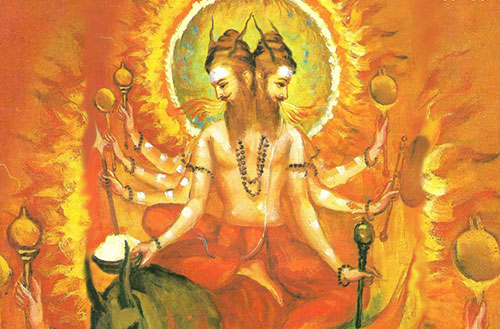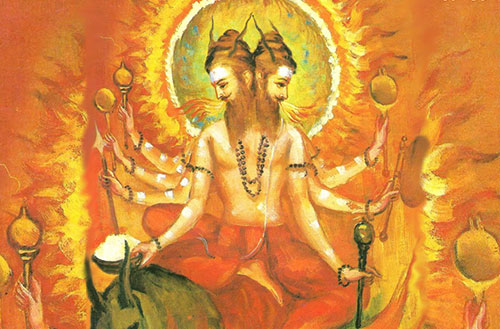
October 02, 2025
Dieties/devta gan
4 min read
Surya Dev
The Sun is not only the source of light and energy but also revered as a divine force in Hindu tradition. Worshipped as Surya Dev, the Sun is considered the giver of health, vitality, and prosperity. Many people begin their day with Surya Namaskar or by offering water to the rising Sun, believing it brings blessings and removes negativity. The Sun symbolizes truth, knowledge, and the eternal power that sustains life on Earth.
Surya — Ancient Beliefs Once Called Myths, Now Confirmed by Science
---
Introduction
Across civilizations, Surya (the Sun) has been revered as the giver of life, the cosmic witness,
and the ultimate source of energy. Ancient Indian texts describe Surya with details that were
often dismissed as religious or symbolic. However, modern science has validated many of these
insights, showing that the ancients were remarkably perceptive about the Sun’s properties, its
effects on life, and its cosmic influence.
---
1. Seven Horses of Surya = Spectrum of Light
In classical iconography, Surya’s chariot is pulled by seven horses. Initially interpreted
symbolically, this aligns remarkably with modern science: sunlight splits into seven visible colors
(VIBGYOR). The ancients encoded this observation centuries before Newton formally
demonstrated the visible spectrum using prisms.
---
2. Surya as the Source of Life
The Rigveda calls Surya the “Prana” or the soul of all moving and unmoving beings. Science
now confirms that photosynthesis, powered by sunlight, forms the foundation of all food chains,
producing oxygen and sustaining life. Without Surya, Earth would be frozen and lifeless.
---
3. Sunlight and Human Health
Ancient practices recommended exposure to morning sunlight and Surya Namaskar. Modern
medicine confirms multiple benefits:
Vitamin D synthesis, essential for bones, immunity, and mental health.
Circadian rhythm regulation, aligning sleep and alertness with day-night cycles.
Light therapy applications, including treatment for neonatal jaundice, depression, and skin
disorders.
The ancients may not have known the biochemical mechanisms, but they recognized the
life-enhancing effects of sunlight.
---
4. Surya as the All-Seeing Witness
Texts describe Surya as the eternal observer of all deeds. This poetic notion has a modern
parallel: Earth-observing satellites powered by solar energy use the Sun’s radiation to capture
visible, infrared, and ultraviolet data, monitoring agriculture, weather patterns, oceans, and
urban activity.
---
5. Eclipses — Rahu, Ketu, and Astronomy
Ancient mythology narrates Rahu and Ketu swallowing the Sun during eclipses. Indian
astronomers like Aryabhata (5th century CE) correctly explained eclipses as the shadows of the
Earth and Moon, centuries before European acceptance. This demonstrates that symbolic
myths were intertwined with observational astronomy.
---
6. Solar Cycles and Agriculture
Festivals like Makar Sankranti celebrate the Sun’s northward movement (Uttarayana). Farmers
traditionally aligned planting and harvesting with these solar movements. Science today
confirms that solar cycles (~11-year sunspot cycles) affect rainfall, monsoons, and even satellite
communications, validating ancient solar-based agricultural timing.
---
7. Surya’s Energy is Inexhaustible
Vedic hymns describe Surya’s energy as eternal. Modern science confirms that while the Sun
has a finite lifetime (~5 billion years), it is effectively inexhaustible for human civilization. The
global solar energy revolution — from photovoltaic panels to concentrated solar power —
transforms this ancient insight into practical, sustainable energy.
---
8. Solar Storms — The Wrath of Surya
Some texts describe Surya’s wrath causing chaos on Earth. Science now identifies solar flares
and coronal mass ejections that can disrupt satellites, power grids, GPS, and aviation. The
Carrington Event (1859) produced auroras worldwide and damaged telegraph networks,
showing ancient warnings of Sun’s destructive power were prescient.
---
9. Temples as Solar Observatories
Temples such as Konark (Odisha) and Modhera (Gujarat) were architecturally aligned to capture
sunlight during equinoxes and solstices. Sunlight illuminates central idols precisely, effectively
turning these temples into ancient solar observatories, combining devotion with advanced
astronomy.
---
10. Surya and Cosmic Winds
Upanishadic texts describe Surya as a portal connecting cosmic realms. Modern science finds
the Sun emits a continuous solar wind — streams of charged particles interacting with Earth’s
magnetic field, creating auroras and shaping space weather. Ancient poetic descriptions
resonate with real astrophysical phenomena.
---
11. Surya and the Rhythm of Time
Surya’s daily journey structured calendars, rituals, and daily life. Science today shows sunlight
as the master regulator of circadian rhythms. Humans deprived of natural sunlight face sleep
disorders, metabolic disruptions, and mood disturbances, validating ancient emphasis on
sun-aligned daily routines.
---
12. Surya and Immunity
Ayurveda links sunlight to “ojas” (vital energy and immunity). Modern research confirms that
Vitamin D from sunlight enhances immune defenses, reducing risks of infections, autoimmune
diseases, and some cancers. The ancients understood Sun’s therapeutic potential centuries
before modern clinical studies.
---
Conclusion
What was once dismissed as religious symbolism or myth in Surya traditions is increasingly
validated by science. From the seven colors of light to solar winds, from circadian health to solar
energy, ancient insights about the Sun were remarkably accurate. Surya remains both a divine
symbol and a scientific reality — bridging the realms of tradition and empirical knowledge.
---
Introduction
Across civilizations, Surya (the Sun) has been revered as the giver of life, the cosmic witness,
and the ultimate source of energy. Ancient Indian texts describe Surya with details that were
often dismissed as religious or symbolic. However, modern science has validated many of these
insights, showing that the ancients were remarkably perceptive about the Sun’s properties, its
effects on life, and its cosmic influence.
---
1. Seven Horses of Surya = Spectrum of Light
In classical iconography, Surya’s chariot is pulled by seven horses. Initially interpreted
symbolically, this aligns remarkably with modern science: sunlight splits into seven visible colors
(VIBGYOR). The ancients encoded this observation centuries before Newton formally
demonstrated the visible spectrum using prisms.
---
2. Surya as the Source of Life
The Rigveda calls Surya the “Prana” or the soul of all moving and unmoving beings. Science
now confirms that photosynthesis, powered by sunlight, forms the foundation of all food chains,
producing oxygen and sustaining life. Without Surya, Earth would be frozen and lifeless.
---
3. Sunlight and Human Health
Ancient practices recommended exposure to morning sunlight and Surya Namaskar. Modern
medicine confirms multiple benefits:
Vitamin D synthesis, essential for bones, immunity, and mental health.
Circadian rhythm regulation, aligning sleep and alertness with day-night cycles.
Light therapy applications, including treatment for neonatal jaundice, depression, and skin
disorders.
The ancients may not have known the biochemical mechanisms, but they recognized the
life-enhancing effects of sunlight.
---
4. Surya as the All-Seeing Witness
Texts describe Surya as the eternal observer of all deeds. This poetic notion has a modern
parallel: Earth-observing satellites powered by solar energy use the Sun’s radiation to capture
visible, infrared, and ultraviolet data, monitoring agriculture, weather patterns, oceans, and
urban activity.
---
5. Eclipses — Rahu, Ketu, and Astronomy
Ancient mythology narrates Rahu and Ketu swallowing the Sun during eclipses. Indian
astronomers like Aryabhata (5th century CE) correctly explained eclipses as the shadows of the
Earth and Moon, centuries before European acceptance. This demonstrates that symbolic
myths were intertwined with observational astronomy.
---
6. Solar Cycles and Agriculture
Festivals like Makar Sankranti celebrate the Sun’s northward movement (Uttarayana). Farmers
traditionally aligned planting and harvesting with these solar movements. Science today
confirms that solar cycles (~11-year sunspot cycles) affect rainfall, monsoons, and even satellite
communications, validating ancient solar-based agricultural timing.
---
7. Surya’s Energy is Inexhaustible
Vedic hymns describe Surya’s energy as eternal. Modern science confirms that while the Sun
has a finite lifetime (~5 billion years), it is effectively inexhaustible for human civilization. The
global solar energy revolution — from photovoltaic panels to concentrated solar power —
transforms this ancient insight into practical, sustainable energy.
---
8. Solar Storms — The Wrath of Surya
Some texts describe Surya’s wrath causing chaos on Earth. Science now identifies solar flares
and coronal mass ejections that can disrupt satellites, power grids, GPS, and aviation. The
Carrington Event (1859) produced auroras worldwide and damaged telegraph networks,
showing ancient warnings of Sun’s destructive power were prescient.
---
9. Temples as Solar Observatories
Temples such as Konark (Odisha) and Modhera (Gujarat) were architecturally aligned to capture
sunlight during equinoxes and solstices. Sunlight illuminates central idols precisely, effectively
turning these temples into ancient solar observatories, combining devotion with advanced
astronomy.
---
10. Surya and Cosmic Winds
Upanishadic texts describe Surya as a portal connecting cosmic realms. Modern science finds
the Sun emits a continuous solar wind — streams of charged particles interacting with Earth’s
magnetic field, creating auroras and shaping space weather. Ancient poetic descriptions
resonate with real astrophysical phenomena.
---
11. Surya and the Rhythm of Time
Surya’s daily journey structured calendars, rituals, and daily life. Science today shows sunlight
as the master regulator of circadian rhythms. Humans deprived of natural sunlight face sleep
disorders, metabolic disruptions, and mood disturbances, validating ancient emphasis on
sun-aligned daily routines.
---
12. Surya and Immunity
Ayurveda links sunlight to “ojas” (vital energy and immunity). Modern research confirms that
Vitamin D from sunlight enhances immune defenses, reducing risks of infections, autoimmune
diseases, and some cancers. The ancients understood Sun’s therapeutic potential centuries
before modern clinical studies.
---
Conclusion
What was once dismissed as religious symbolism or myth in Surya traditions is increasingly
validated by science. From the seven colors of light to solar winds, from circadian health to solar
energy, ancient insights about the Sun were remarkably accurate. Surya remains both a divine
symbol and a scientific reality — bridging the realms of tradition and empirical knowledge.


